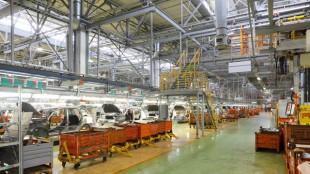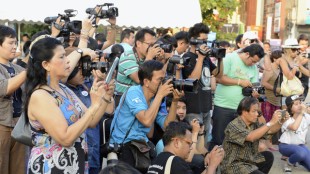
-
 WWF blasts Sweden, Finland over logging practices
WWF blasts Sweden, Finland over logging practices
-
How things stand in China-US trade tensions with Trump 2.0

-
 Most Asian markets rise after Wall Street's AI-fuelled rally
Most Asian markets rise after Wall Street's AI-fuelled rally
-
Colman to kick off Sundance as film world reels from LA fires

-
 Chief US diplomat vows 'unwavering support' for Israel
Chief US diplomat vows 'unwavering support' for Israel
-
Fire-hit Hollywood awaits Oscar nominees, with 'Emilia Perez' in front

-
 Nearly 200 Bangkok schools close over air pollution
Nearly 200 Bangkok schools close over air pollution
-
Daring attack pays off for Spain's Romo in Tour Down Under win

-
 Napoli host arch-rivals Juventus riding wave of Scudetto enthusiasm
Napoli host arch-rivals Juventus riding wave of Scudetto enthusiasm
-
Alpine skiing: Five things about the Kitzbuehel downhill

-
 J-pop star Nakai to retire after sex misconduct allegations: media
J-pop star Nakai to retire after sex misconduct allegations: media
-
New rider in town: Somalia's first woman equestrian turns heads

-
 Melbourne doubles feud as Kichenok accuses Mladenovic of 'direct threat'
Melbourne doubles feud as Kichenok accuses Mladenovic of 'direct threat'
-
Trump to take virtual centre stage in Davos

-
 Friedrich Merz: millionaire conservative on verge of German chancellery
Friedrich Merz: millionaire conservative on verge of German chancellery
-
Trump's return darkens mood as Germany heads to elections

-
 Pochettino happy after 'amazing' USA beat Costa Rica
Pochettino happy after 'amazing' USA beat Costa Rica
-
Most Asian markets extend AI-fuelled rally

-
 Bangladesh student revolutionaries' dreams dented by joblessness
Bangladesh student revolutionaries' dreams dented by joblessness
-
S. Korea investigators recommend Yoon be charged with insurrection, abuse of power

-
 Solar power surpasses coal in EU for first time
Solar power surpasses coal in EU for first time
-
Musk, Wikipedia founder in row over how to describe 'Nazi salute'

-
 Axel Rudakubana: troubled teen whose knife rampage shocked Britain
Axel Rudakubana: troubled teen whose knife rampage shocked Britain
-
Sasaki vows to 'give best' to fire-torn LA at Dodgers unveiling

-
 UK teen faces sentencing over murders that sparked riots
UK teen faces sentencing over murders that sparked riots
-
Larry Ellison, tech's original maverick, makes Trump era return

-
 Trump push to 'drill, baby, drill' may hit industry roadblock
Trump push to 'drill, baby, drill' may hit industry roadblock
-
Instagram courts TikTok stars during turbulent times

-
 Political crisis hits South Korea growth: central bank
Political crisis hits South Korea growth: central bank
-
Elephants are not people, US judges say

-
 Sinner aiming to be 'better, stronger' in Australian Open semi
Sinner aiming to be 'better, stronger' in Australian Open semi
-
Mass evacuations after explosive new fire erupts near Los Angeles

-
 Phoenix Motor Appoints Tony Zhou as Chief Technology Officer
Phoenix Motor Appoints Tony Zhou as Chief Technology Officer
-
Angle PLC Announces Trading Update

-
 The Now Corporation (OTC:NWPN) In Conjunction With Subsidiary Green Rain Solar Inc., Launch a Visionary Video Showcasing Solar Energy Solutions
The Now Corporation (OTC:NWPN) In Conjunction With Subsidiary Green Rain Solar Inc., Launch a Visionary Video Showcasing Solar Energy Solutions
-
Guardiola concedes Man City 'could not cope' with PSG as European hopes flicker

-
 PSG push Man City to brink with stunning Champions League comeback
PSG push Man City to brink with stunning Champions League comeback
-
Arteta wants sunshine break as Arsenal move towards last 16

-
 PSG comeback floors Man City as Arsenal near Champions League last 16
PSG comeback floors Man City as Arsenal near Champions League last 16
-
Trump toughens crackdown on immigration and diversity

-
 Celtic make 'little bit of history' with Champions League progress
Celtic make 'little bit of history' with Champions League progress
-
As Trump declares 'Gulf of America,' US enters name wars

-
 Celtic make Champions League progress thanks to Young Boys own goal
Celtic make Champions League progress thanks to Young Boys own goal
-
Trump's tariff threats are 'leverage,' says informal economic advisor

-
 Trump halts refugee arrivals in crackdown
Trump halts refugee arrivals in crackdown
-
Gangs could overrun Haiti capital if aid falls short: UN chief

-
 PSG sink Man City with stunning Champions League comeback
PSG sink Man City with stunning Champions League comeback
-
Leao sinks Girona and pushes Milan into Champions League top eight

-
 Feyenoord stun toothless Bayern in Champions League
Feyenoord stun toothless Bayern in Champions League
-
Arsenal on course for last 16 after beating Dinamo


Russia tactics in Ukraine war mirror Syria testing ground: experts
Besieging cities, shelling civilian infrastructure and arranging "safe corridors": the tactics used by Russia in its war on Ukraine mirror those it tested and fine-tuned to drain resistance in Syria's conflict.
But unlike its Syria play book, the challenge Russia faces from a Western-backed army in Ukraine dwarfs that of Syrian rebels who lacked military might or broad international backing, analysts said.
Russia entered Syria's civil war in 2015 on the side of President Bashar al-Assad's regime, allowing Damascus to clock up decisive victories in the decade-long conflict.
Since President Vladimir Putin ordered an invasion on February 24, tens of thousands of Russian troops have swarmed into Ukraine, where they have shelled urban centres and forced people to flee, sparking international outrage.
Moscow denies targeting civilian areas in Ukraine, despite widespread evidence suggesting otherwise, with Western powers and rights groups accusing it of committing possible war crimes.
A French military source said Russia's operations in Ukraine marked a "change of scale".
"Syria was a small theatre," he told AFP on condition of anonymity.
But many of the tactics deployed in Ukraine draw from Russia's battles in Syria, where it tested weapons systems and gained vital combat experience.
"For Russia, Syria is a training ground for men and equipment," said analyst Fabrice Balanche.
- Strategy to 'terrorise' -
Russia has long been accused by rights groups of supporting Syria's regime in besieging civilian populations and bombing infrastructure to draw rebels out of key areas.
To bolster Assad, "Russia's first goal in Syria was to reconquer big cities," including the economic hub of Aleppo and rebel-held districts around Damascus, Balanche said.
In Ukraine, Russia's push towards major cities including Kyiv, Kharkiv and Odessa follows a similar pattern but is meant to strip legitimacy from authorities there, he said.
Balanche said indiscriminate Russian bombing of hospitals and schools is another aspect of the Syrian conflict playing out in Ukraine as part of a strategy to "terrorise" civilians.
At least 270 medical facilities in Syria have been attacked by Russia and Assad's regime since 2011, according to the Syrian Archive, a non-profit organisation that archives digital material from the war.
Russia also targeted schools and markets during a blistering Aleppo offensive in 2016 and a devastating 2019-2020 campaign against rebels in neighbouring Idlib province, the country's last major opposition bastion, according to rights groups.
"Russia bombs military targets... then health and energy infrastructure to make life impossible for civilians and to push them to leave," Balanche told AFP.
"Once the civilians are gone, it is easier for the army to move forward."
Last month, Human Rights Watch and Amnesty International accused Russia of using cluster munitions on a hospital and school in Kharkiv, saying the attacks could constitute war crimes.
On Wednesday, Russian forces reportedly bombed a children's hospital in the Ukrainian city of Mariupol that Kyiv says killed three people, including a girl.
That attack sparked international outrage with many global powers accusing Russia of committing an atrocity.
- Different battlefield -
In another parallel strategy, Russia has announced so-called safe corridors to allow civilians to exit Ukrainian cities it has laid siege to.
It is a strategy tried and tested in Syria, sometimes resulting in the death, injury and detention of civilians who try to escape besieged rebel districts without international guarantees, according to experts.
But Russia faces a different landscape in Ukraine, where it has deployed a much larger contingent, in a high-stakes intervention.
"In Syria, Russia primarily relied on its air power and certain specialised units to advise and assist the pro-Assad forces," said Nicholas Heras of the Newlines Institute in Washington.
"Whereas in Ukraine the Russians are the (main) fighting force," he added.
Another key difference, according to Heras, concerns the capabilities of Russia's opponents.
In Ukraine, Russia is confronted by an army that is armed and supported by Western nations, Heras said, flagging its anti-air and anti-armour capabilities.
Meanwhile, "Russia was involved in a minor league war in Syria where it had total dominance," he added.
According to Anton Mardasov, a non-resident expert at the Russian International Affairs Council, Moscow now has a sharper sense of its weapons systems.
It has "corrected many of the shortcomings of high-precision ground, sea and air-based weapons that were identified during the use of missile systems in Syria," he told AFP.
"In Ukraine, high-precision weapons are used quite actively and accurately."
A.Williams--AT
